
The Ethiopian birr (Br) stands as one of Africa’s most historically significant currencies, with roots stretching back centuries through Ethiopia’s rich and independent history. As the only African nation to successfully resist European colonization (except for a brief Italian occupation), Ethiopia’s currency reflects its unique cultural heritage and economic journey. Whether you’re planning a trip to this East African nation, conducting business there, or simply interested in world currencies, understanding the birr provides fascinating insights into Ethiopia’s past and present economic landscape.
Official Currency Name and Symbol
Ethiopian birr (Br) banknotes and the Amharic symbol ብር
The official currency of Ethiopia is the Ethiopian birr, abbreviated as “Br” in Latin script and written as “ብር” in Amharic script (Ethiopia’s official working language). The word “birr” itself derives from the Ge’ez and Amharic languages, meaning “silver” – a reference to its historical value standard. The birr is subdivided into 100 santims (derived from the French “centime”), though santims are rarely used in everyday transactions due to inflation.
There have been various proposals for an official birr symbol, with most based on the Ge’ez fidel ብ (bə). One suggested symbol comprises the bə with two horizontal slashes on the left-hand side, though no single symbol has been universally adopted in the way that the dollar ($) or euro (€) symbols have been standardized.
“The birr (ብር) is the primary unit of currency in Ethiopia. It is subdivided into 100 santims.”
The currency code for the Ethiopian birr in international banking and foreign exchange is ETB, with the numeric code 230 according to the ISO 4217 standard. This code is used in international money transfers, currency exchange services, and global financial markets.
A Brief History of Ethiopian Currency

Maria Theresa thaler, which circulated in Ethiopia before the modern birr
Ethiopia’s monetary history is as rich and complex as its cultural heritage, evolving through several distinct phases:
Early Exchange Systems (Pre-18th Century)
Although the ancient Kingdom of Aksum issued copper, silver, and gold coins as early as the 3rd century CE, by the 18th century, trade in Ethiopia was primarily facilitated through barter or “primitive money.” This included items such as cloth bolts, iron bars, beads, gold bracelets, and even cartridges. Perhaps the most widespread medium of exchange was blocks of salt called amole tchew (አሞሌ), which circulated from their origins in the Danakil Depression to as far south as Lake Zway. The use of amole tchew is documented as late as 1911.
Maria Theresa Thaler Era (1855-1894)
Between 1771 and 1805, the Maria Theresa thaler, a silver coin from Austria, gradually gained acceptance in Ethiopia. Known locally as the birr (literally ‘silver’) or talari (ታላሪ), it was officially adopted as Ethiopia’s standard coin in 1855. The Indian rupee and Mexican dollar were also used in foreign trade during this period, though most coins were hoarded rather than circulated.
First National Currency (1894-1936)
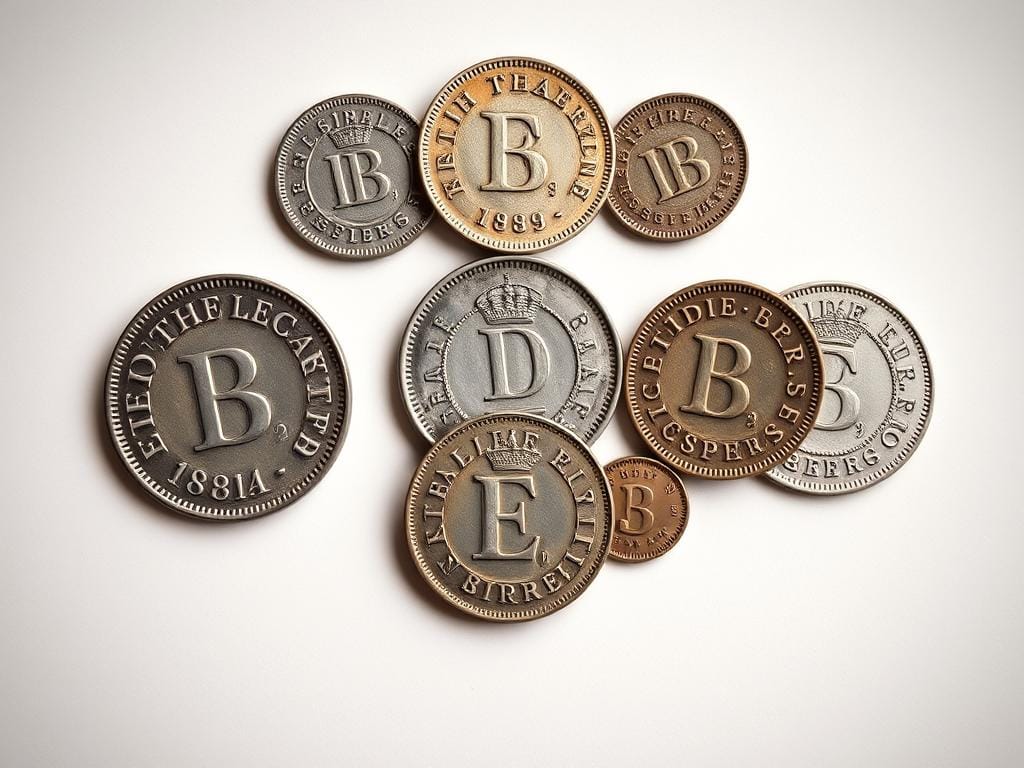
Early Ethiopian birr coins from Emperor Menelik II’s reign
Emperor Menelik II had considered issuing an Ethiopian currency as early as 1875. Following the Treaty of Uccialli, an agreement was negotiated allowing Ethiopia to issue its own currency, with coins to be struck at the Italian mint. Despite deteriorating relations with Italy, Menelik persevered, and on February 10, 1893, he issued a decree for a new coinage. The first coins were struck the following year, though in limited quantities.
After Ethiopia’s victory in the Battle of Adwa (1896), a new Ethiopian coinage appeared. The silver birr maintained the same weight and fineness as before, but smaller denominations were reorganized. These coins were produced at the Paris Mint, which produced 815,000 birr in the first three years.
Bank of Abyssinia and Paper Currency (1906-1936)
The Bank of Abyssinia was established in 1905 by Emperor Menelik II and the European banking group behind the National Bank of Egypt. The bank put banknotes into circulation in 1915, denominated birr in Amharic and thaler in English. These notes initially had limited circulation, primarily used by merchants and foreigners in the capital for larger transactions.
Bank of Ethiopia Era (1931-1936)
In 1931, Emperor Haile Selassie bought out the Bank of Abyssinia for £235,000 sterling to make it a purely Ethiopian institution, reorganizing it as the Bank of Ethiopia. At the same time, the currency was decimalized, with the birr becoming equal to 100 metonnyas (often written matonas). The text on banknotes appeared in Amharic, French, and English.
Italian Occupation (1936-1941)
Following the Italian occupation and attempted transformation of Ethiopia into Italian East Africa, the Italian lira was introduced on July 15, 1936. Ethiopian banknotes were withdrawn at a rate of 3 lire per talari (birr). Despite efforts to increase the use of Italian paper money by raising exchange rates for silver coins, many Ethiopians kept their Ethiopian coins and banknotes.
British Administration (1941-1945)
During the East African Campaign of 1941, British forces liberated Ethiopia and brought various currencies with them. The East African shilling became the money of account on July 1, 1942, eventually becoming the sole legal tender until 1945.
Modern Birr (1945-Present)
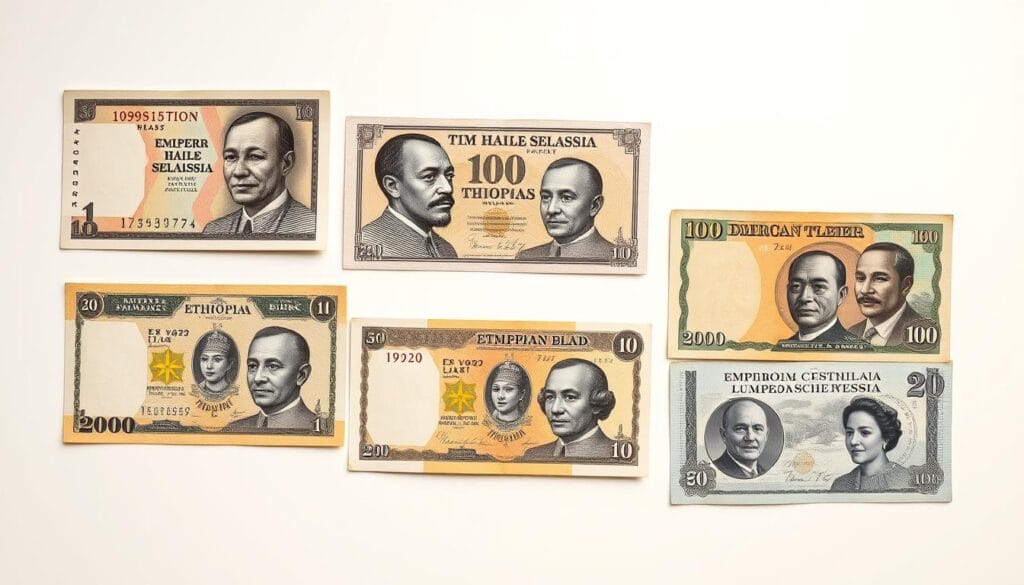
Evolution of Ethiopian birr banknotes from Emperor Haile Selassie era to modern designs
The birr was reintroduced on July 23, 1945, at a rate of 1 birr per 2 shillings. Initially, the name “Ethiopian dollar” was used in the English text on banknotes, though “birr” became the official name in all languages in 1976. The currency was initially pegged to the U.S. dollar at 2.48447 birr = US$1, slightly adjusted to 2.50 birr = US$1 in 1963.
Through Ethiopia’s various political transitions—from imperial rule under Haile Selassie to the Derg military government (1974-1991) and the current federal democratic republic—the birr has remained the national currency, though with changing designs reflecting each era’s political ideology.
Current Banknotes and Coins in Circulation
Banknotes

Current Ethiopian birr banknotes from the 2020 series (10, 50, 100, and 200 birr)
On September 14, 2020, Ethiopia introduced a new series of banknotes with enhanced security features and distinctive design elements. This currency reform was implemented to tackle hoarding, counterfeiting, and other economic issues affecting the country. The new series replaced the previous 10, 50, and 100 birr notes while introducing a new 200 birr denomination.
| Denomination | Obverse Design | Reverse Design | Color |
| 10 birr | Camel, coffee harvest | Two couples | Green |
| 50 birr | Tractor | Factory | Orange/Brown |
| 100 birr | Enqulal Gemb fortress (Gondar) | Sof Omar caves; City gate, Harar | Blue |
| 200 birr | Pigeon | Capricorn | Purple |
The new banknotes feature improved security elements including holographic strips, color-shifting ink, and watermarks. The designs reflect Ethiopia’s natural and historical features while also representing the country’s development aspirations through imagery of agriculture, industry, and cultural heritage.
The older 5-birr note, while still legal tender, is being gradually replaced with a coin. During the currency transition, the Ethiopian government reported that over 113 billion birr ($3.6 billion) was being held outside the banking system, and the reform aimed to bring this money into formal financial channels.
Coins

Current Ethiopian birr coins in circulation
The current coins in circulation include:
- 5 santim (2006/EE1998)
- 10 santim (2004/EE1996)
- 25 santim (2016/EE2008; also called semuni)
- 50 santim (2016/EE2008)
- 1 birr (2016/EE2008)
Ethiopian coins have distinctive features that help identify them. Coins dated before 1977 (EE1969) feature the Conquering Lion of Judah (a crowned rampant lion holding a cross). Coins dated 1977 (EE1969) or later depict the head of a roaring lion with a flowing mane.
The dates on Ethiopian coins appear in Amharic, following the Ethiopian calendar (EE), which is approximately seven to eight years behind the Gregorian calendar. Coins have been struck at several mints, including Paris, Berlin, and Addis Ababa, with those without mint marks generally struck at Addis Ababa.
Note: Due to inflation, coins of smaller denominations (particularly 5 and 10 santim) have become increasingly rare in everyday transactions, with most small purchases rounded to the nearest 25 santim or 1 birr.
Exchange Rate Information

Ethiopian birr exchange rate fluctuations against major currencies (2019-2024)
Recent Devaluation and Current Rates
In 2024, Ethiopia undertook significant economic reforms, including the liberalization of its foreign exchange market, leading to the floating of the Ethiopian birr. This policy shift, spearheaded by the National Bank of Ethiopia (NBE), was supported by $13.5 billion from international partners, primarily multilateral lenders like the IMF and World Bank.
The impact was dramatic: the Ethiopian birr experienced a substantial decline, falling approximately 63% against the US dollar within a week of floating. The exchange rate as indicated by the Commercial Bank of Ethiopia (CBE) plummeted from 57 birr per US dollar to approximately 106 birr per dollar by mid-2024.
| Currency | Approximate Rate (August 2024) | Pre-Devaluation Rate (July 2024) | Change |
| 1 USD | 106-114 ETB | 57 ETB | +86% |
| 1 EUR | 115-120 ETB | 62 ETB | +85% |
| 1 GBP | 135-140 ETB | 73 ETB | +85% |
Important: Exchange rates can fluctuate significantly, especially following the 2024 currency liberalization. For the most current rates, check with the National Bank of Ethiopia, major commercial banks, or reliable currency exchange services before traveling or conducting business in Ethiopia.
Historical Exchange Rate Trends
Historically, the Ethiopian birr was relatively stable compared to many African currencies due to the government’s managed exchange rate policy. From 2005 to 2019, the birr gradually depreciated against major currencies, but in a controlled manner:
| Year | Average ETB per USD |
| 2005 | 8.31 |
| 2006 | 8.75 |
| 2007 | 9.39 |
| 2008 | 9.92 |
| 2009 | 11.78 (approx.) |
| 2019 | 29-30 |
| 2023 | 54-56 |
The 2024 devaluation represents the most significant change in the birr’s value in recent history, marking a departure from the previous managed exchange rate system to a more market-determined approach.
Economic Context and Recent Developments

Addis Ababa’s financial district, hub of Ethiopia’s economic development
Ethiopia’s Economic Landscape
Ethiopia has been one of Africa’s fastest-growing economies over the past decade, with real GDP growth averaging around 10% between 2004 and 2014. However, the country faces significant structural challenges, including high inflation, foreign exchange shortages, and a large trade deficit.
Agriculture constitutes around 85% of the labor force, though the service sector represents the largest portion of GDP. Coffee remains Ethiopia’s largest foreign exchange earner, with the country being Africa’s largest coffee producer. Other important exports include oilseeds, gold, leather products, and more recently, floriculture products.
2024 Currency Reform and Its Implications

Ethiopian Prime Minister Abiy Ahmed announcing economic reforms
The 2024 currency liberalization was part of broader economic reforms aimed at addressing persistent macroeconomic imbalances. Key aspects of these reforms include:
- Flexible Exchange Rate: Moving from a managed exchange rate to a market-determined system
- IMF Support: Securing a $3.4 billion loan from the International Monetary Fund
- World Bank Assistance: Over $15 billion in financial support, including direct grants, debt extensions, and investment commitments
- Wage Adjustments: Significant salary increases for public sector employees, particularly favoring lower-income earners
- Banking Reforms: Measures to strengthen the financial sector and improve access to foreign currency
Inflation and Cost of Living
Inflation has been a persistent challenge for Ethiopia’s economy. According to the National Bank of Ethiopia, inflation peaked at 35.1% in December 2021, stabilizing slightly at 33.8% by December 2022. Prior to the 2024 currency reform, projections suggested a decrease to 24.5% by the end of 2023 and further to 18.5% by the end of 2024.
However, the sharp devaluation of the birr in 2024 has led to significant price increases for basic commodities, particularly imported goods. This has intensified the cost-of-living crisis, especially affecting public sector employees and urban residents.
The rapid currency devaluation has created challenges for businesses and consumers alike, with prices for imported goods rising sharply. Travelers should be prepared for potential price volatility and budget accordingly.
Impact on International Development and Business
For international organizations and businesses operating in Ethiopia, the currency devaluation presents both challenges and opportunities:
Challenges
- Rising operational costs due to inflation
- Increased prices for imported goods and equipment
- Budget pressures for projects with local currency funding
- Potential social instability due to cost-of-living increases
Opportunities
- Increased purchasing power for organizations with USD-denominated budgets
- Potential export competitiveness for Ethiopian products
- Improved access to foreign currency for legitimate business needs
- Reduced black market premium and associated distortions
The government has emphasized that these reforms, while painful in the short term, are necessary for long-term economic stability and growth. The success of these measures will depend on effective implementation and complementary policies to protect vulnerable populations from the negative impacts of adjustment.
Practical Information for Travelers

Currency exchange service in Addis Ababa with current rates displayed
Where to Exchange Money
Travelers to Ethiopia have several options for exchanging foreign currency:
- Banks: Commercial banks such as Commercial Bank of Ethiopia, Dashen Bank, and Awash Bank offer currency exchange services with official rates. These are generally available in major cities and at international airports.
- Hotels: Many international hotels in Addis Ababa and other major tourist destinations offer currency exchange services, though often at less favorable rates than banks.
- Authorized Forex Bureaus: These can be found in major cities and tourist areas, offering competitive rates and often more convenient hours than banks.
- Bole International Airport: Currency exchange services are available at Addis Ababa’s international airport, though rates may be less favorable than in the city.
Tip: Always ask for a receipt when exchanging currency, as you may need it to convert unused birr back to foreign currency when leaving the country.
Acceptance of Foreign Currencies

Some hotels and tourist establishments accept US dollars
While the Ethiopian birr is the only legal tender for everyday transactions in Ethiopia, some exceptions exist:
- US Dollars: Some international hotels, tour operators, and high-end establishments catering to tourists may accept US dollars, particularly for larger expenses like accommodation or tour packages.
- Euros: Less widely accepted than US dollars but may be taken at some tourist-oriented businesses.
- Credit Cards: Major credit cards (Visa and MasterCard) are increasingly accepted at international hotels, upscale restaurants, and some shops in Addis Ababa, but their acceptance remains limited outside the capital.
It’s important to note that most everyday transactions, including restaurants, local transportation, markets, and smaller shops, require payment in birr. Even where foreign currencies are accepted, the exchange rate offered may not be favorable.
ATMs and Banking Services
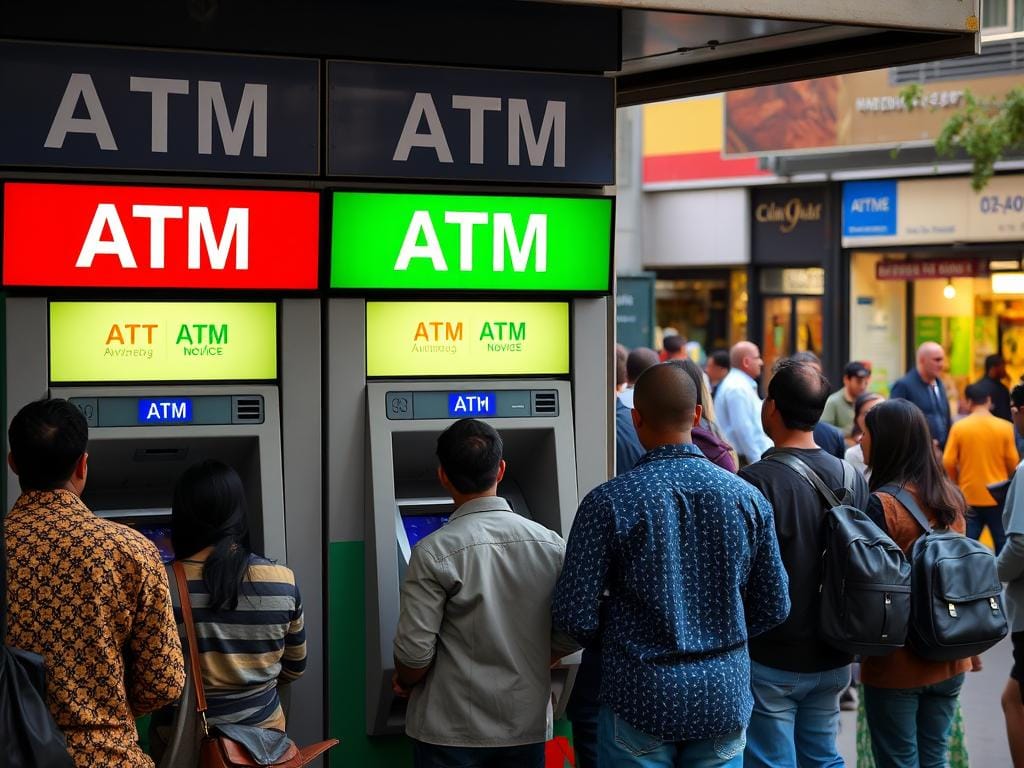
ATM machines in Addis Ababa for withdrawing Ethiopian birr
ATM availability in Ethiopia has improved significantly in recent years, particularly in Addis Ababa and other major cities:
- ATM Networks: Dashen Bank has the most extensive ATM network that accepts international cards. Commercial Bank of Ethiopia and some other private banks also have ATMs that accept foreign cards.
- Card Compatibility: Most ATMs accept Visa cards, with fewer accepting MasterCard. American Express and other cards have very limited acceptance.
- Withdrawal Limits: Daily withdrawal limits vary by bank but are typically around 4,000-5,000 birr per transaction, with a maximum of 2-3 transactions per day.
- Locations: ATMs can be found at major banks, shopping centers, hotels, and Bole International Airport in Addis Ababa. Outside the capital, ATM availability becomes more limited, particularly in rural areas.
Important: ATMs occasionally run out of cash or experience network issues. It’s advisable to withdraw money in advance when traveling to smaller towns or rural areas where banking infrastructure is limited.
Money-Saving Tips
To get the most value when using Ethiopian currency:
- Compare Rates: Check exchange rates at different banks and forex bureaus before exchanging large amounts.
- Avoid Black Market: Despite potentially better rates, illegal currency exchange carries risks of counterfeit notes and legal consequences.
- Carry Small Denominations: Many small businesses and taxis may have difficulty providing change for large bills.
- Inform Your Bank: Notify your bank of your travel plans to prevent your cards from being blocked for suspicious activity.
- Budget for Cash: Given the limited credit card acceptance, ensure you have adequate cash for your needs, especially when traveling outside major cities.
Commercial Bank of Ethiopia main branch in Addis Ababa
Cultural and Historical Significance of Currency Designs
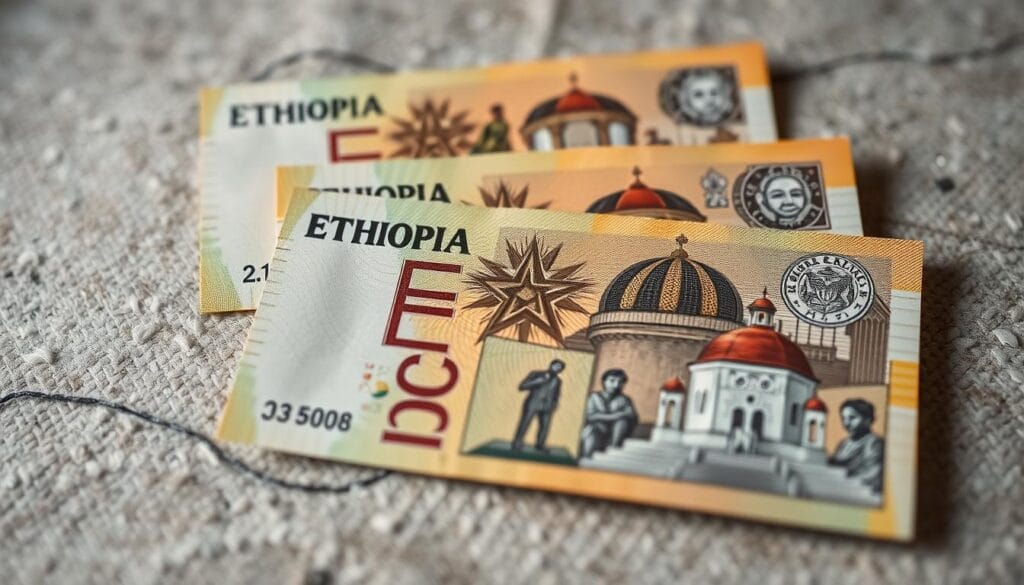
Cultural and historical elements featured on Ethiopian birr banknotes
Ethiopian currency designs offer fascinating insights into the country’s rich history, cultural heritage, and national aspirations. The imagery on birr notes and coins has evolved over time, reflecting changing political systems and national priorities while maintaining connections to Ethiopia’s unique identity.
Historical Symbolism
Early Ethiopian coins and banknotes during the imperial era prominently featured symbols of the monarchy:
- The Lion of Judah: A powerful symbol of the Ethiopian monarchy, representing the claimed lineage from King Solomon and the Queen of Sheba. This crowned lion holding a cross appeared on coins and banknotes during the imperial period.
- Imperial Portraits: Images of emperors, particularly Haile Selassie, were featured on currency during the imperial era, emphasizing the central role of the monarchy in Ethiopian identity.
- Orthodox Christian Imagery: Reflecting Ethiopia’s long Christian history, religious symbols and church architecture appeared on some currency designs.
Post-Revolution Symbolism
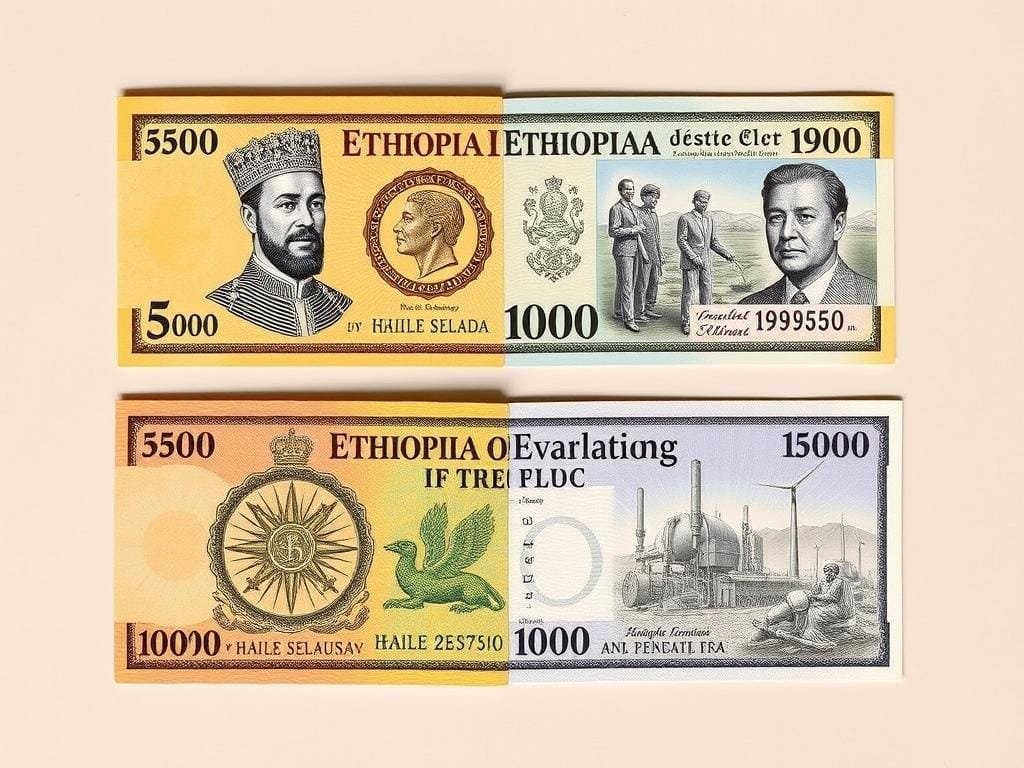
Comparison of currency designs from imperial and post-revolution Ethiopia
After the 1974 revolution that overthrew Emperor Haile Selassie, currency designs shifted dramatically to reflect the new socialist ideology:
- Workers and Farmers: Images of industrial workers, farmers, and agricultural scenes replaced royal imagery, emphasizing the socialist focus on labor and production.
- Industrial Development: Factories, dams, and other infrastructure projects featured prominently, highlighting modernization and development goals.
- National Unity: Designs incorporated elements representing Ethiopia’s diverse ethnic groups, promoting a unified national identity.
Contemporary Designs
The current banknotes, introduced in 2020, blend traditional cultural elements with forward-looking themes:
Cultural Heritage
- Historical Monuments: The 100 birr note features the Enqulal Gemb fortress in Gondar and the historic city gate of Harar, celebrating Ethiopia’s architectural heritage.
- Natural Wonders: The Sof Omar caves, one of Africa’s largest cave systems, appear on the 100 birr note, highlighting Ethiopia’s natural beauty.
- Traditional Activities: Coffee harvesting scenes on the 10 birr note represent Ethiopia’s most famous export and cultural tradition.
Development Aspirations
- Agricultural Modernization: The tractor on the 50 birr note symbolizes the modernization of Ethiopia’s agricultural sector.
- Industrialization: Factory imagery on the 50 birr reverse represents Ethiopia’s industrial development goals.
- Unity in Diversity: The depiction of couples on the 10 birr reverse symbolizes Ethiopia’s diverse ethnic composition and national unity.
These design elements not only serve aesthetic purposes but also function as expressions of national identity and aspirations. Through its currency, Ethiopia communicates its historical continuity, cultural richness, and vision for the future.
“The notes are reflective of the natural, historical features of the country besides anticipating the future strategies like industrialization and modern agriculture.”
Currency Regulations and Restrictions

Currency checks at Ethiopian customs, Bole International Airport
Currency Import Regulations
When entering Ethiopia, travelers should be aware of the following regulations regarding bringing currency into the country:
- Foreign Currency Declaration: Visitors entering Ethiopia with foreign currency exceeding the equivalent of $3,000 USD must declare this amount to customs officials upon arrival.
- Documentation: A currency declaration form must be completed and submitted to customs. This form serves as proof of legal importation and will be required if you wish to convert large amounts of local currency back to foreign currency when departing.
- No Restrictions on Amount: There is no upper limit on how much foreign currency you can bring into Ethiopia, provided it is properly declared.
- Ethiopian Birr Import: It is prohibited to import Ethiopian birr into the country. The currency must be obtained within Ethiopia through official channels.
Currency Export Regulations

Currency declaration form required when exporting large amounts of foreign currency
When leaving Ethiopia, the following regulations apply:
- Foreign Currency Export: Visitors may take out the amount of foreign currency they declared upon entry. Any amount exceeding the declared sum must be supported by bank withdrawal receipts or other official documentation.
- Ethiopian Birr Export: The export of Ethiopian birr is strictly limited to 200 birr per person. This restriction is enforced to prevent currency speculation and maintain control over the national currency.
- Converting Birr Before Departure: Travelers should convert unspent birr back to foreign currency before departure, as exchanging Ethiopian currency outside the country is extremely difficult, if not impossible.
- Receipts Requirement: To convert birr back to foreign currency, you must present the original currency exchange receipts from when you initially changed your money.
Important: Failure to comply with currency regulations can result in confiscation of undeclared funds and potential legal consequences. Always keep your currency declaration forms and exchange receipts throughout your stay in Ethiopia.
Banking Regulations for Foreigners
Foreign visitors should be aware of these additional banking regulations:
- Bank Accounts: Non-resident foreigners can open foreign currency accounts at Ethiopian banks with proper documentation, typically including a passport and visa.
- Business Transactions: Foreign businesses operating in Ethiopia must follow specific regulations regarding currency conversion and repatriation of profits, as outlined by the National Bank of Ethiopia.
- Foreign Exchange Services: Only authorized banks and forex bureaus are legally permitted to exchange currency. Using unofficial currency traders is illegal and carries significant risks.
- Payment for Services: Many tourism services, particularly those offered by international hotels and tour operators, may be payable in foreign currency, but most everyday transactions must be conducted in birr.
Note for Business Travelers: Ethiopia has gradually been liberalizing its foreign exchange regulations to attract investment. As of 2024, a law allows expatriate Ethiopians to invest in Ethiopia’s financial service industry, and the floating exchange rate system is intended to improve access to foreign currency for legitimate business needs.
Conclusion

Ethiopia’s evolving economy reflected in modern marketplace activities
The Ethiopian birr stands as a fascinating window into the country’s rich history, cultural heritage, and economic evolution. From its origins in the Maria Theresa thaler to the modern digital-ready currency of today, the birr has adapted to changing political systems, economic policies, and technological advancements while maintaining its role as a symbol of Ethiopian sovereignty.
The 2024 currency liberalization marks a significant turning point in Ethiopia’s economic management, bringing both challenges and opportunities. While the sharp devaluation has created immediate hardships through higher prices for imported goods, it also represents a step toward a more sustainable economic model with improved access to foreign exchange and reduced market distortions.
For travelers and businesses engaging with Ethiopia, understanding the birr’s history, current status, and regulations is essential for navigating financial transactions effectively. As Ethiopia continues its economic development journey, its currency will likely evolve further, reflecting the country’s unique blend of ancient heritage and modern aspirations.
Planning a Trip to Ethiopia?
Get our comprehensive guide to managing money in Ethiopia, including up-to-date exchange rates, recommended exchange locations, and tips for getting the best value during your visit.
Frequently Asked Questions About Ethiopian Currency
What is the currency of Ethiopia called?
The currency of Ethiopia is called the Ethiopian birr (ETB). The word “birr” means “silver” in Amharic and Ge’ez languages, reflecting its historical value standard. It is subdivided into 100 santims, though santims are rarely used in everyday transactions due to inflation.
What is the current exchange rate for Ethiopian birr?
Following the 2024 currency liberalization, the Ethiopian birr experienced significant devaluation. As of August 2024, the exchange rate was approximately 106-114 birr per US dollar, compared to around 57 birr per dollar before the devaluation. Exchange rates fluctuate daily, so it’s advisable to check current rates with the National Bank of Ethiopia or reliable financial sources before traveling.
Can I use US dollars or euros in Ethiopia?
While the Ethiopian birr is the only legal tender for everyday transactions, some international hotels, tour operators, and high-end establishments catering to tourists may accept US dollars, particularly for larger expenses like accommodation or tour packages. Euros are less widely accepted. However, for most everyday transactions, including restaurants, local transportation, markets, and smaller shops, you will need Ethiopian birr.
Where can I exchange money in Ethiopia?
You can exchange foreign currency at commercial banks (such as Commercial Bank of Ethiopia, Dashen Bank, and Awash Bank), authorized forex bureaus, international hotels, and at Bole International Airport in Addis Ababa. Banks generally offer the best rates, while airport exchanges may be less favorable but more convenient for arriving travelers.
Are credit cards widely accepted in Ethiopia?
Credit card acceptance in Ethiopia is limited primarily to international hotels, upscale restaurants, and some shops in Addis Ababa. Visa is more widely accepted than MasterCard, while American Express has very limited acceptance. Outside the capital, credit card acceptance becomes increasingly rare. It’s advisable to carry sufficient cash, especially when traveling to smaller towns or rural areas.
How much Ethiopian birr can I take out of the country?
The export of Ethiopian birr is strictly limited to 200 birr per person. This restriction is enforced to prevent currency speculation and maintain control over the national currency. Travelers should convert unspent birr back to foreign currency before departure, as exchanging Ethiopian currency outside the country is extremely difficult, if not impossible. To convert birr back to foreign currency, you must present the original currency exchange receipts.

Adam G
This post was created by Adam G, a seasoned financial writer with a passion for explaining currency exchange and market movements
